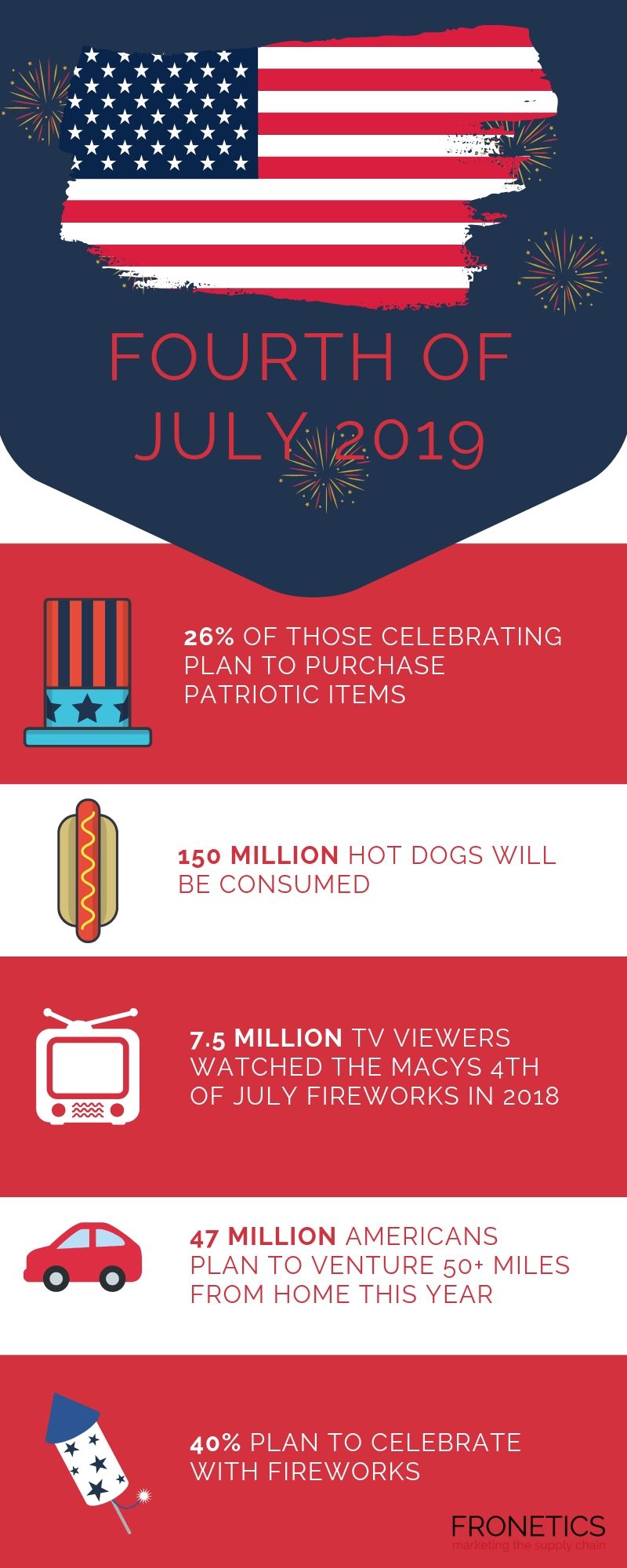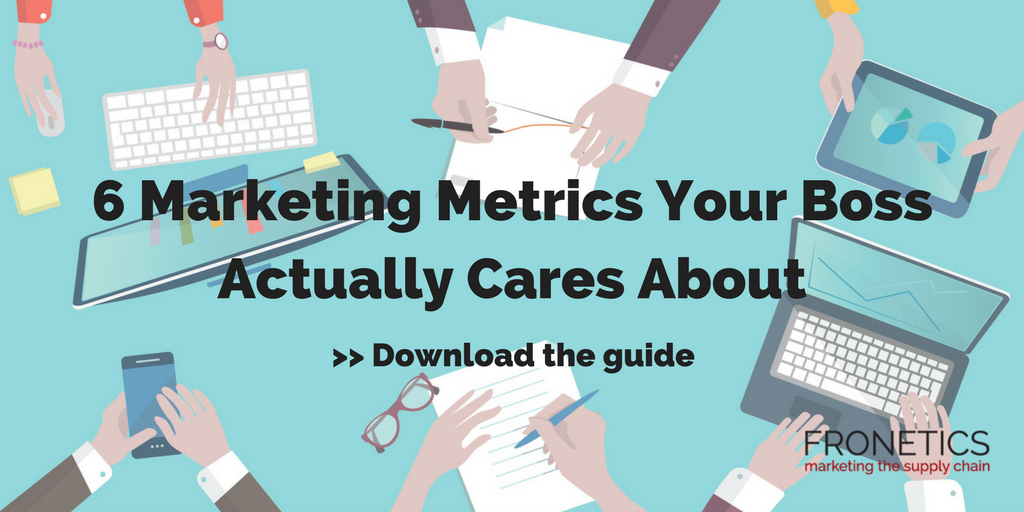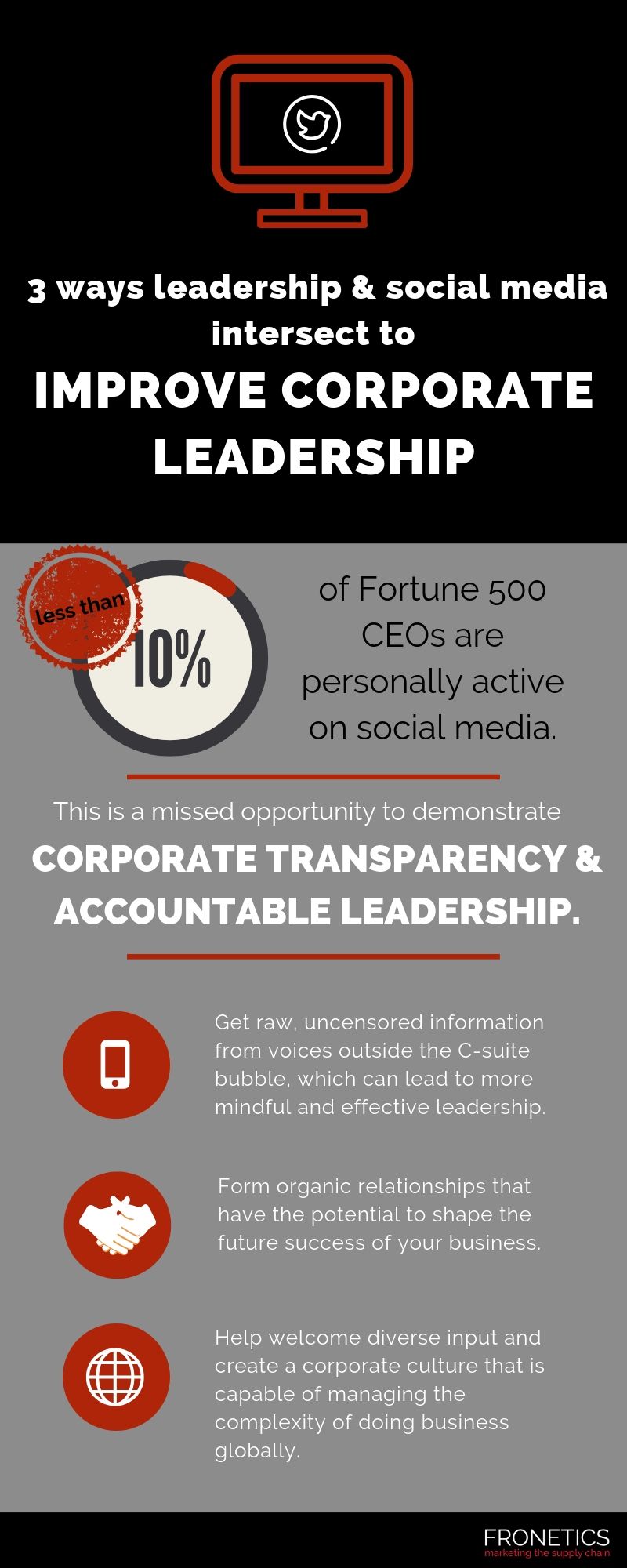
by Fronetics | Jul 3, 2019 | Blog, Current Events, Logistics, Supply Chain
U.S. Consumers will shell out $6.78 billion on food for cookouts and picnics for the Fourth of July 2019.
Highlights:
- Holiday food spending is projected to be down slightly from recent years.
- More Americans than ever (48.9 million) are planning to travel this Fourth of July.
- Men are expected to spend about $10 more on average than women.
As Americans get ready to celebrate the nation’s 243rd Independence Day, the National Retail Federation is making its annual list of projections for spending. Holidays have a big impact on the supply chain, and the Fourth of July is no exception.
Who’s spending what?
This year, 86% of Americans are planning to celebrate the Fourth of July. That number is down very slightly from recent years, with 87% celebrating in 2018 and 88% in 2017. Consequently, the average expected spending is down by just a few dollars this year, coming in at $73.33 per person, as compared with $75.35 last year.
Interestingly, while men and women are planning to celebrate in just about equal numbers (86% and 85% respectively), women plan to be significantly more frugal than men when it comes to purchasing food. Men are expected to spend $78.68 on average, while women plan to spend $68.20 each.
What’s everyone doing for the Fourth of July?
Cookouts, BBQs, and picnics are in most people’s plans (61%), with 40% planning to attend fireworks or other community celebrations, and 11% are attending parades. 26% of Americans are expected to purchase patriotic merchandise for Independence Day this year.
Even though overall spending is expected to be slightly down this year, AAA estimates that a record-breaking 48.9 million Americans are planning to travel this Fourth of July. This is a 4.1% rise over last year, with 1.9 million more people planning to get on the road this year. AAA credits the record numbers to lower gas prices, strong economic fundamentals, low unemployment, and rising disposable incomes.
Hot dog stats
Americans eat hot dogs better than just about anyone, and this Fourth of July, we’re expected to chomp down on roughly 150 million. It’s worth remembering that a year ago, Joey Chestnut set the record for the number of hot dogs eaten in 10 minutes, working his way through an impressive 74. Hot dogs are best washed down with a patriotic toast, and Americans are expected to spend upwards of $1.6 billion on beer and wine.
However you plan to spend the Fourth of July, Fronetics wishes you and your family a fun-filled and safe weekend.

(Made with Canva)
Related posts:

by Fronetics | Jul 2, 2019 | Blog, Content Marketing, Marketing, Packaging, Supply Chain
Looking for ways to make your morning commute more productive? These 4 podcasts for packaging and supply chain professionals are on our must-listen list.
Highlights:
- Download podcast episodes for on-the-go access to innovations, insights, and analysis from leading industry figures.
- Talking Logistics with Adrian Gonzalez is both highly approachable and insightful.
- SupplyChainBrain’s episode on Trends in Packaging is a must-listen for packaging industry professionals.
It wasn’t all that long ago when the options for the morning commute were limited by what CDs you had in your car (or Walkman) or what was playing on the radio. With the rise of podcasts, we’re no longer stuck choosing between rowdy drive-time radio hosts or NPR. We’ve chosen 4 podcasts for packaging and supply chain professionals that offer top-notch industry analysis, insights, and conversations.
Podcasts are a series of digital audio files that enable users to subscribe and download, so listening on the go doesn’t mean using up your data plan. There are all kinds of podcasts out there on essentially every topic you can imagine. These 4 podcasts for packaging and supply chain professionals will feed your mind, expand your insights, and some might even make you crack a smile!
4 podcasts for packaging and supply chain professionals
1) Talking Logistics with Adrian Gonzalez
We love supply chain and logistics analyst Adrian Gonzalez’s conversational podcast. Listen to a few episodes, and you’ll feel like you’re in on a conversation with your brightest professional contacts. Gonzalez’s easy-to-follow format on Talking Logistics gives it a friendly, casual feel, but it’s bristling with keen insights. The podcast features interviews with industry thought leaders and newsmakers, including supply chain and packaging executives from leading retail companies, academics, authors, and executives from 3PLs.
Recent must-download episodes:
2) SupplyChainBrain
SupplyChainBrain is a series of in-depth conversations with industry leaders, consultants, academics, and experts from every aspect of supply chain management, including packaging. Always current, the podcast has been producing weekly episodes since its launch in 2013. It covers topics like retail shifts, blockchain innovations, labor shortages, and the Internet of Things, and its excellent overview episode “Trends in Packaging: The State of the Art” is a must-listen.
Recent must-download episodes:
3) LogicalLogistics
Though the episodes are older, Bellair Expediting’s podcast is worth listening to, particularly for the packaging industry. It features interviews with executives and experts in transportation, logistics, packaging, and more.
Must-download episodes:
4) Straight Talk with Supply Chain Insights
Research and advisory firm Supply Chain Insights hosts its weekly podcast, Straight Talk, which covers topics from global thinking to trends in data and packaging. Most episodes take the form of conversations and interviews with executives and experts, sharing supply chain and logistics insights.
Recent must-download episodes:
What podcasts for packaging and supply chain professionals have you been listening to lately?
Recent posts:


by Fronetics | Jun 27, 2019 | Blog, Current Events, Marketing, Social Media
Also this month in social media news: Facebook releases details of its forthcoming cryptocurrency, and Instagram Pushes IGTV With Horizontal Video LinkedIn updates ad features.
Highlights:
- Facebook is removing several Information sections from business Pages, while also testing a feature that lets users preview posts.
- LinkedIn is increasing transparency for native advertising and boosting its data personalization capabilities with the acquisition of Drawbridge.
- Facebook’s new cryptocurrency, Libra, will enable fee-free fund transfers.
This month, Facebook is dominating the headlines when it comes to social media news. On the heels of its annual F8 developer conference last month, the social media giant is making several changes to its Business Pages, removing certain info sections and reportedly working on a new “Preview” option.
Meanwhile, LinkedIn is updating its ad features in several important ways for businesses. In addition to bringing more transparency to native ads, the social media site has acquired data personalization platform Drawbridge in a push to improve its ad targeting. In the world of Instagram and video, IGTV will now support horizontal video, as the platform seeks to make its IGTV feature increasingly appealing for users. Keep reading for more on these social media news items from June 2019.
Facebook makes key changes to Business pages
Facebook marketing has always been full of constant changes, but lately, as the platform responds to the fallout from Cambridge Analytica and other confidence-shaking scandals, it’s becoming increasingly more challenging for businesses.
Information sections are being removed
This month, changes to business Pages include the removal of certain information sections, effective August 1, including Company Overview, Biography, Mission, Affiliation, and Personal Interests. Prompts to Page admins inform them of the removals and encourage them to “consider adding this info to your Page’s description.” Theories abound as to why the social network is making this change. We think it’s likely that, as Social Media Today posits, Facebook is attempting to “reduce any unnecessary data collection in order to lessen its potential tracking and targeting issues.”
New “Preview” option is being tested
Meanwhile, Facebook is reportedly also testing a new “Preview” option for business Page posts, enabling marketers to see what a post will look like before hitting “Share,” with options to view in mobile or desktop format. In the flurry of more dismal news for businesses on Facebook, this feature would be a welcome bit of good news for social media managers. Being able to see exactly what your content will look like before you post it can help optimize your efforts on the platform and give you an extra failsafe when it comes to catching errors and typos before content goes live.
Instagram announces that IGTV now supports landscape videos
It’s been just over a year since Instagram rolled out its IGTV feature, making tweaks along the way, most notably allowing users to publish previews of IGTV content in the main Instagram feed. Instagram reports that since the launch of the improved publishing feature, “We’ve seen viewers spending more time with IGTV and a surge of new original content from creators of all sizes.”
IGTV is getting another makeover, as the platform responds to user requests to be able to upload landscape videos. Horizontal videos will now be supported in addition to vertical videos, both in the Instagram app and the IGTV standalone app. Viewers will be able to turn their devices sideways and view the content full screen. This is good news for marketers, as publishing video content on IGTV just got a little easier and more flexible. Rather than needing to adapt videos for the vertical format, marketers will now have an easier time integrating content straight from YouTube, for example.
Facebook releases details of its new cryptocurrency, Libra
This month, after extended speculation, Facebook has released the official outline and documentation for its forthcoming cryptocurrency, Libra. There aren’t a lot of surprises in the release. Libra will enable fee-free transfer of funds through Facebook’s “Calibra” crypto subsidiary.
According to Facebook, “From the beginning, Calibra will let you send Libra to almost anyone with a smartphone, as easily and instantly as you might send a text message and at low to no cost. And, in time, we hope to offer additional services for people and businesses, like paying bills with the push of a button, buying a cup of coffee with the scan of a code, or riding your local public transit without needing to carry cash or a metro pass.”
LinkedIn makes two updates to its ad features
In an effort to provide to bring more transparency to ads on LinkedIn, engendering trust among users, the network is introducing a new Ads tab on LinkedIn Pages. According to the platform’s announcement, “In this tab, members will be able to view all Sponsored Content (native ads running in the LinkedIn feed) that advertisers have run on LinkedIn in the past six months.” Clicking on the ads through the new tab won’t charge advertisers, and these engagements also won’t impact campaign reporting.
LinkedIn is also upping its game when it comes to data personalization. To help businesses better reach their audiences on the platform, LinkedIn is acquiring Drawbridge, Inc. “We believe Drawbridge’s team and technology will allow us to accelerate the capabilities of our Marketing Solutions platform, helping our customers better reach and understand their professional audiences and measure the ROI of their campaigns across mobile and desktop,” says LinkedIn’s Tomer Cohen.
What social media news are you following this month?
Related posts:


by Fronetics | Jun 25, 2019 | Blog, Leadership, Marketing, Social Media
The intersection of leadership and social media is receiving growing attention. A leadership expert has identified 3 surprising ways social media can create more effective leaders.
Highlights:
- Very few Fortune 500 CEOs are personally engaged in social media.
- Corporate leaders can get valuable unfiltered information through social media use and encourage a culture of free-flowing information.
- Social media’s transformative leadership effects can only come into play when leaders are personally engaged.
Social media is a nearly ubiquitous presence in our lives, both personal and professional. As the influence of these platforms extends, the connection between leadership and social media is increasingly gaining attention.
A recent report from Chief Executive found that the vast majority of American CEOs have no personal presence on social media, relying instead on ghostwriters or marketing staff to post on their behalf. Less than 10% of Fortune 500 CEOs are personally active on social media, despite growing public demand for corporate transparency and accountable leadership.
Engagement Leadership expert Céline Schillinger, in exploring the relationship between leadership and social media, has identified more than just the practical benefits (like strengthening brand, managing crises, and presenting a human face to the public) of CEOs on social media. Schillinger has identified three key ways that social media can actually create better leaders.
3 ways leadership and social media intersect to improve corporate leaders

(Made with Canva)
1) Access to unfiltered information
One of the biggest changes that social media has wrought on modern society is the widespread, unfettered dissemination of information, directly from its source. Boiled down to its essence, social media gives everyone a voice. For today’s corporate leader, access to unfiltered information comes at a premium: “Be it competent and well-intended, or self-protective and risk averse, CEOs’ entourage form a distorting bubble,” writes Schillinger.
What better way than social media to burst the bubble and get the raw, uncensored information that leads to mindful and effective corporate leadership? It’s an ideal way to combat the gap in perception between employees and managers, for example, or the service gap between customer expectations and the customer experience. Using social media gives leaders access to real-time, accurate information from the people their businesses serve.
Schillinger says that the informational benefits of leadership and social media extend further. “By role modelling curiosity for unfiltered information and by exchanging thoughts and ideas directly through social media, leaders give symbolic ‘permission’ to their organization to do the same,” she writes. Social media can help leaders create a corporate culture that encourages the free flow of accurate, uncensored information.
2) Relational engagement and enhanced business performance
Best-selling author Brian Solis, who explores the effects of technology on business, marketing, and culture, writes, “Brands are co-created by consumers through shared experiences.” That’s actually a pretty radical message. Particularly for those of us in the marketing world, it’s easy to get caught up with the idea that brands are purely created through the careful work of marketing teams, designers, and image consultants.
But, in fact, what Solis is saying is that thanks in large part to social media, the totality of what makes up a brand identity no longer fits in the frame of what businesses create themselves. Brands are relational. For this reason, corporate leaders need to embrace the idea that effective leadership is “contextual and relational.”
“Relationship building is now a required core competency for all professionals — and for senior leaders in particular,” writes Schillinger. Social media gives leaders the opportunity to form the kinds or organic relationships that have no less than the potential to shape the core of their brands. These are “connections that arise within communities, born from a shared sense of belonging, acknowledgment of emotions, and co-creation of work.”
3) Transformation through mindset change: where leadership and social media intersect
Social media usage has transformational potential: it leads to new modes of interaction and relating to others. As Schillinger points out, “This is why it is fundamentally experiential and cannot be delegated without dampening its impact.” For corporate leaders, social media can help welcome diverse input and create a culture that is capable of managing the complexity of doing business in a global economy.
Schillinger identifies a powerful example of the transformative power of social media on corporate leaders, resulting in unmatched improvement in output. Corporate leaders at Sanofi Pasteur, a vaccines manufacturer, chose to personally involve themselves in an internal online community, interacting on a weekly basis with their employees. Their “asking questions, sharing insights, recognizing achievements, and ‘liking’ posts… had a huge positive impact on their own perception, their leadership, and the flows of knowledge between employees.”
The connection between effective leadership and social media participation is a topic that we’re really only beginning to understand. But what’s clear at this point is that when leaders commit to personal engagement in social platforms, information flows are enhanced, brands are strengthened, and the businesses unlock the kind of transformative potential that leads to unprecedented success.
Related posts:

by Fronetics | Jun 20, 2019 | Blog, Content Marketing, Logistics, Marketing, Social Media, Supply Chain
Participating in social media is increasingly important for businesses in the supply chain. Here are the 3 steps to proving social media ROI.
Highlights:
- It may seem obvious, but too many businesses approach social media marketing with vague goals or none at all.
- Once you’ve set your goals and identified your key metrics, it’s time to implement a system that will track and measure your metrics.
- Once you’ve calculated ROI for your social media platforms, it’s time to think strategically about optimizing your content marketing resources in terms of allocation and timing.
Video transcript:
I’m Elizabeth Hines, Creative Director at Fronetics, and today we’re talking about three steps to prove social media ROI.
Participating in social media is increasingly important for businesses in the supply chain. But many clients tell us they have a hard time getting approval for the expense because it’s notoriously difficult to measure the return on investment.
Well it’s true that many of the benefits of social media — like greater brand awareness and improved communication with customers — are difficult to quantify, there are some ways to prove the ROI of your participation in social media.
Here are the 3 steps to proving social media ROI:
1. Set goals
I’m not talking “grow your business” or other vague benchmarks like that. I mean “increase web traffic from social by 10% over the next 90 days.” Really specific benchmarks and goals are important in measuring success.
2. Track and measure
Make sure you have means to accurately measure how you’re doing against your goals. All the social platforms have excellent analytics tools to help with this. We also use tools like Google Analytics and HubSpot.
3. React
Look at your metrics in the context of your goals. Once you figure out what’s helping you meet those objectives and where you’re falling short, you can tweak your efforts to be more successful and to make sure that you’re actually achieving your ROI.
For more information on social media and all things digital marketing, visit our website at Fronetics.com
Related posts:









